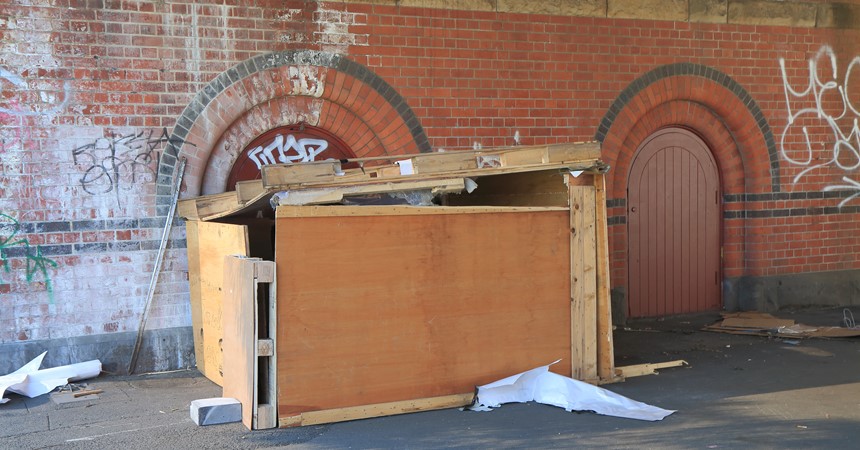The Australian Catholic Bishops Conference recently reaffirmed addressing homelessness as a necessary focus of the Church’s mission. The Bishops acknowledged that in a rich country like Australia, it is a national shame that we have people who for reasons beyond their control do not have a secure roof over their head. Whilst the Catholic Church and its agencies already provide housing and homelessness services, with the growing number of people becoming homeless or being uncertain of a roof over their head, the Church needs to do more.
From the 2011 Census, more than 105,000 individuals were homeless and relied on increasingly stretched support services to assist them to find secure housing. Anecdotal evidence from Catholic social services is that the number of people who are homeless has continued to increase. This appalling situation has flow on effects because without a secure and affordable place to call home, other stresses in the lives of individuals and families cannot be addressed.
People who are homeless can include those who are sleeping rough, including in cars, and people staying in temporary, overcrowded, unstable or substandard accommodation. It also includes ‘couch surfing’, where a person manages to find temporary accommodation with family or friends. Many people who are homeless cycle between homelessness and marginal housing. People are also staying in crisis accommodation for longer because they have nowhere else to go. [1]
There are various reasons for the increase in homelessness. Domestic and family violence accounts for 23 per cent of homelessness, financial difficulties account for 16 per cent, and 15 per cent is due to a housing crisis.[2] Most of the increase in homelessness between 2006 and 2011 was due to people living in severely crowded dwellings and about three-quarters of this increase was accounted for by people who were born overseas. Overcrowding or ‘homefullness’ is a challenge for many Indigenous families and communities, due to a shortage of suitable housing.
Analysis undertaken by Homelessness Australia[3] from the 2011 Census shows the following facts about Australians experiencing homelessness:
- 56 per cent are male.
- 44 per cent are female.
- 27 per cent are children under 18.
- 25 per cent are Indigenous.
- 30 per cent are born overseas.
- Close to 40 per cent are living in severely overcrowded dwellings.
- 20 per cent are in supported accommodation.
- 17 per cent live in boarding houses.
- 17 per cent are staying temporarily with other households.
The majority of older women who experience homelessness do so following separation, widowhood or domestic violence. For a child, homelessness means missing out on many of the things other children take for granted. For example, children may not be able to form friendship groups or enjoy stable schooling if they live in transient housing.
People experiencing mental illness, particularly episodic mental illness, face a range of difficulties in maintaining stable housing. This in turn can have adverse effects on a person’s mental health.[4]
The first analysis of the 2016 Census shows there has been a steady decline in home ownership rates overall – down by 2.9 per cent from 64.9 per cent of all Australian households in 2006, to 62 per cent in 2016. Unfortunately, the rates of social housing have also declined from 4.7 per cent in 2006 to 4 per cent in 2016, further limiting the availability of affordable housing for low income households.[5] Research undertaken by Anglicare in Sydney and Melbourne, provided evidence about the impact of high rents on low income households. With over 20,000 rental properties advertised for rent in these two cities, less than 40 properties were considered suitable for households on income support.[6]
Catholic parishes, social service agencies, hospitals, schools, universities and the Australian Catholic Housing Alliance are already providing volunteer and professional services and support for people experiencing homelessness in a number of ways, including with prevention, crisis response and pathways out of homelessness.
Below are some suggestions for consideration by members and organisations within the Catholic Church to respond further to the growing social and economic problem of homelessness. Ask yourself:
- What is your understanding of the nature of homelessness in your diocese?
- Are there opportunities to prevent families and individuals becoming homeless?
- What homelessness services are currently being provided by the Catholic Church and other providers? and
- What can I do to further support these existing services?
The Catholic organisations already working with and for people without homes have extensive and invaluable experience and insights. So do people who are homeless or at risk of being homeless.
This wisdom is invaluable in helping Catholics understand the true dimensions of marginalisation and exclusion. This collective wisdom could, for example, be part of the formation of young people in social justice issues, for example in schools and universities and within Catholic youth festivals and gatherings.
Similarly, understanding of the issues connected with homelessness should be part of the training and religious formation of pastoral workers, permanent deacons, seminarians and candidates for religious life.
Parishes and dioceses can support the Australian Catholic Housing Alliance by promoting the work of the Alliance within dioceses’ finance, property management and social service agencies. In addition, support could be given to using Catholic Development Funds for financing affordable housing projects and developing financing models suitable for development of housing on Church land. Church land, buildings and other property could be surveyed to identify the best sites for low-cost housing projects, with a view to then financing projects.
Looking forward our national challenge is to turn around the drivers of Australia’s growing inequality and poverty and deliver a more equitable distribution of resources, especially for those people most vulnerable and excluded from our economy. Addressing entrenched poverty and disadvantage requires a long-term and strategic investment of resources by governments, business and community sector.
With your support the Catholic Church through its collective experience and influence can continue to advocate for structural change so the most vulnerable members in our community have hope for a better future.
When we, both as Church and as part of society, recognise and confront the injustices that lie at the root of homelessness, we will have done something to realise Jesus’ vision for the most vulnerable.
[1] Department of Families, Housing, Community Services and Indigenous Affairs (2008) The Road Home: A National Approach to Reducing Homelessness, p. viii.
[2] Homelessness Australia, Fact Sheets, http://www.homelessnessaustralia.org.au/index.php/about-homelessness/fact-sheets.
[3] Homelessness Australia, ‘About homelessness’, http://www.homelessnessaustralia.org.au/index.php/about-homelessness/homeless-statistics.
[4] Mental Health Australia (2012), ‘Mental health, housing and homelessness in Australia – Fact Sheet’, https://mhaustralia.org/fact-sheets/mental-health-housing-and-homelessness-australia-fact-sheet.
[5] Wendy Stone, Margaret Reynolds and Terry Burke (2017), ‘Home ownership remains strong in Australia but it masks other problems: Census data’, The Conversation, 27 June 2017.
[6] Anglicare Rental Affordability Snapshot 2017 Private rental market failure http://www.anglicare.asn.au/home/2012/04/29/private-rental-market-failure accessed 7th July 2017

